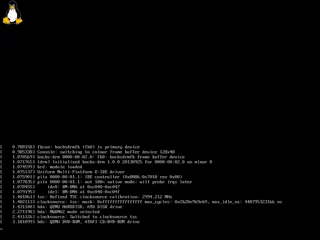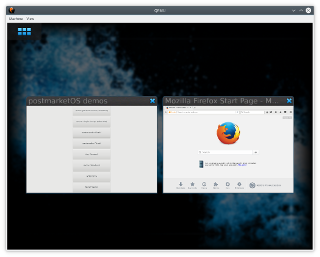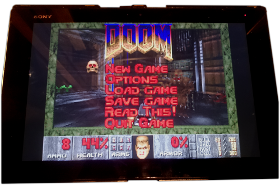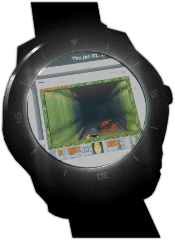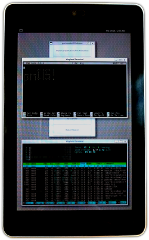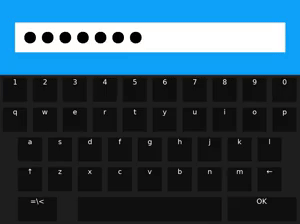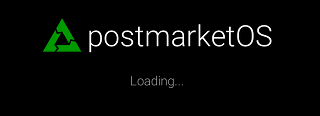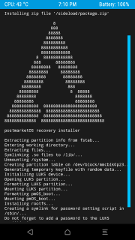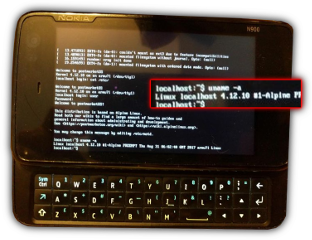Sustainable Approach For Linux on Phones
We are building an alternative to Android and other mobile operating systems by not forking but bending the time-proven Alpine Linux distribution to fit our purpose. Instead of using Android's build process, we build small software packages that can be installed with Alpine's package manager. To minimize the amount of effort for maintenance, we want every device to require only one device-specific package and share everything else.
At this point our OS is only suitable for fellow hackers who enjoy using the command-line and want to improve postmarketOS. Telephony or other typical smartphone tasks are not working yet.
Why We Evolve in Many Directions
Why don't we focus on one "flagship" device and stop making blog posts until it can be used as daily driver?
Our philosophy is that community-based FLOSS projects need to become known during the development phase to fellow developers. Our way of doing that is through periodically posting reports summarizing our real progress.
The postmarketOS community is a collective group of hackers who contribute to this project in their free time. We won't tell someone who wants to, for example, extend postmarketOS to run Doom on their smartwatch that their idea has no benefit to the project's vision. Such activities demonstrate the flexibility of postmarketOS and oftentimes leads to improvements to the project's codebase as new requirements are implemented to cover previously unforeseen use cases. In addition, these fun activities also increase our collective knowledge about the software and hardware we work with. But most importantly we don't want to, or plan to, take the fun away. Because without being fun and rewarding, a free time project becomes a dead project.
It's not all about running Doom though, there are also individuals in the project who have the most fun by actually bringing the project towards this daily-driver vision. Read on to learn about both the incredibly beneficial efforts as well as the fun exercises we have done since the last post!
Integrated QEMU Support
The idea of providing a device specific package for QEMU was introduced back in July "so it will be easier to try the project and/or develop userspace". Although the initial PR #56 didn't make it, the idea got picked up again and today we can provide you with an implementation of exactly that vision. All you need to dive right into running postmarketOS on QEMU is to install Python (3.4+), git, QEMU, and run the following commands. As expected, pmbootstrap does everything in chroots in the install step, so your host operating system does not get touched.
$ git clone https://gitlab.com/postmarketOS/pmbootstrap.git
$ cd pmbootstrap
$ ./pmbootstrap.py init # choose "qemu-amd64"
$ ./pmbootstrap.py install --no-fde
$ ./pmbootstrap.py qemu
Thanks to: @mmaret, @MartijnBraam, @PabloCastellano
Early Work on New User Interfaces
Since postmarketOS was released, we have been using Wayland's reference compositor Weston as a UI. However, as stated in #62, it "is a cool demo, but far from a usable day-to-day shell people can work with. We need to provide a sane UI."
plasma-mobile (KDE's plasma desktop for phones)
Alpine provided quite a few challenges along the way, such as the usage of the more standards compliant musl libc instead of the commonly used glibc.
Luckily @mpyne already provided patches in KDE's bugtracker that we were able to use. @bshah not only helped us with the port, but also mentioned postmarketOS in his plasma-mobile talk at KDE's Akademy 2017 (slides, video). This is definitely a huge step in the direction towards making plasma-mobile work on postmarketOS! We're excited to see where this is heading, and would greatly appreciate any help from interested developers. Jump right in with QEMU and the unofficial binary packages for KDE/Plasma!
Thanks to: @bshah, @mpyne, @PureTryOut
Hildon
While Hildon is based on X11 instead of Wayland, it is still a lightweight phone interface suitable for older devices.
"Of Course it Runs Doom!"
mesa package so that all Alpine users can benefit from it!
Thanks to: @Bloo, @Opendata26
Other New Devices
We have nine new devices in the last 50 days! In addition to the two mentioned above, we also have:
Thanks to: @antonok, @ata2001, @Bloo, @drebrez, @kskarthik, @Victor9, @wfranken, @yuvadm and everyone who helped them in the chat
Initramfs is Full of New Features
The initramfs is a small filesystem with an init.sh file that prepares the environment before it passes control to the init system running in the real root partition. For postmarketOS we use it to find and optionally unlock the root partition.
osk-sdl from scratch because we couldn't find an existing one that did not depend on heavy GUI libraries. osk-sdl will allow us to unlock the root filesystem directly with the device's touch screen or physical keyboard (if applicable). It is currently in the process of being integrated into postmarketOS, after which it will fully replace the current method of unlocking via telnet. If unlocking via telnet is a requirement for you, please reach out to us and let us know!
To work around the tight size limitations on some devices which do not support having a large boot.img file, @drebrez implemented the initramfs-extras trick: a second initramfs file stores all the big files and is placed in the unencrypted boot partition. The real initramfs then detects this file by its label and extracts everything from initramfs-extras. At this point the init script works like before and has all files it needs!
Speaking of small size: the system image generated in the installation step doesn't have a fixed size anymore, it now adjusts dynamically! After flashing and booting, the initramfs will check whether the flashed image takes up all available space of the system partition and, if it does not, automatically resizes the partition to use all available space.
Last but not least we did a lot of refactoring, such as placing the deviceinfo file inside the initramfs for easy access to device-specific settings and adding support for a configfs-based USB network setup to help out some devices that need it.
Thanks to: @craftyguy, @Defcat, @drebrez, @ollieparanoid, @PabloCastellano, @MartijnBraam
Interoperability
pmbootstrap install --android-recovery-zip. This allows flashing a device by sideloading this image while TWRP is running with pmbootstrap flasher --method=adb sideload!
fastboot compatible, but their bootloader implements a so-called odin-mode. Samsung expects people to install their proprietary, Windows-only Odin program to be able to flash images in this mode. The protocol has been reverse engineered for some devices and can be used with the open source heimdall program, which has been wrapped with our pmbootstrap. But for some older phones the necessary reverse engineering work has not been done and you still have to run the proprietary program to get anything working at all. @drebrez has implemented an Odin-compatible export option to help out folks in this situation: pmbootstrap flasher export --odin.
Mainline Kernel
One of our previously stated goals is using the mainline Linux kernel on as many mobile devices as possible. This is not as easy as it might sound, since many Linux-based smartphones (Android) require binary drivers which depend on very specific kernel versions. It's a tremendous task to rewrite these drivers to work with the current kernel APIs.
2.6.x to mainline 4.12!
linux-postmarketos package. This package configures the kernel to support multiple devices at once, currently the N900 and QEMU, by supporting kernel modules and multiple device trees. On a side note, it is currently not possible for us to use Alpine's kernels because they do not have support for many components found in smartphones and we wouldn't be as flexible as we are now with temporarily applying patches.
Thanks to: @craftyguy, @MartijnBraam (#228, #159)
New Infrastructure
We now have several different key pieces of infrastructure in place to support ongoing project development! The first and most obvious if you are a returning reader: we have a brand new homepage that hosts both our main landing page, this blog, and has links to all of our online resources. You might have also seen our new logo which - besides looking great - is rendered programmatically!
Our GitHub-based wiki has served us well up until now, but we have outgrown it. We've since migrated to a proper MediaWiki server with complete public backups. Did you know that git has MediaWiki support nowadays?
Travis CI now verifies the checksums of downloads in our package recipes and also runs shellcheck over more scripts across the source tree. With these changes, in combination with numerous bug fixes and requiring that nearly all changes to the master branch are presented as PRs for review, pmbootstrap runs pretty stable now.
With over 100 people in the Matrix/IRC channel and lots of messages coming in every day, we decided to create ##postmarketOS-offtopic to keep the backlog in #postmarketOS a bit shorter.
Thanks to: @ata2001, @CmdrWgls, @MartijnBraam, @ollieparanoid, @yuvadm
Raw numbers
>100 people in the channel- pmbootstrap
- 555 stargazers
- 223 closed PRs
- 185 closed issues
- 75 open issues
- 55 watchers
- 48 forks
- 27 contributors (
git shortlog --summary --numbered | wc -l)
Closing words
What you see here is only the tip of the iceberg. So much work has gone into fixing bugs, and little improvements, that it would be ridiculous to go through the effort and list them all. The community has grown so fast in such a short time and we have people with all kinds of skills on board, ranging from Linux experts to kernel hackers to people who reverse engineer bootloaders (hi @McBitter!). We collaborate with people from other projects as well, such as @pavelmachek, who is close to using his N900 as a daily driver with his own distribution, recently just reached out to us.
So if you read through the whole post, you are probably interested in what we do. Consider contributing to the project, the entry barrier is really low. pmbootstrap automates everything for you and we are more than happy to help you through any issues you encounter in the chat. There are also a lot of opportunities to help with development, so there's plenty to do. And plenty of fun to have. Join us and tell your friends!
